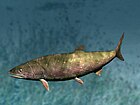Caturidae
| Caturidae Temporal range:
| |
|---|---|

| |
| Fossil specimen of Caturus furcatus from Germany, Upper Jurassic | |
| Scientific classification | |
| Domain: | Eukaryota |
| Kingdom: | Animalia |
| Phylum: | Chordata |
| Class: | Actinopterygii |
| Clade: | Halecomorphi |
| Order: | Amiiformes |
| Superfamily: | †Caturoidea |
| Family: | †Caturidae Owen, 1860 |
Caturidae is an extinct family of predatory fishes belonging to the order Amiiformes (which contains the modern bowfin). The earliest members of the family appeared in the early Late Triassic, reaching an apex of diversity during the Jurassic. The youngest records of the group date to the Early Cretaceous.[1] Members of the family include Caturus, Strobilodus, Amblysemius, and Catutoichthys.[2]
References[edit]
- ^ López-Arbarello, Adriana; Ebert, Martin (January 2023). "Taxonomic status of the caturid genera (Halecomorphi, Caturidae) and their Late Jurassic species". Royal Society Open Science. 10 (1). doi:10.1098/rsos.221318. ISSN 2054-5703. PMC 9832298. PMID 36686548.
- ^ Gouiric-Cavalli, Soledad (2016-06-09). "A new Late Jurassic halecomorph fish from the marine Vaca Muerta Formation, Argentina, southwestern Gondwana". Fossil Record. 19 (2): 119–129. doi:10.5194/fr-19-119-2016. hdl:11336/54624. ISSN 2193-0074.


